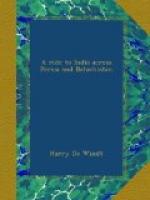She has never moved since her arrival. Her bottom is now covered with coral and shells, her screw stuck hard and fast, while the four steel Krupp guns which she mounts are rusty and useless.
My preparations for Baluchistan were soon completed. The escort furnished me by the Indian Government had been awaiting me for some days at Sonmiani, our starting-point on the coast. A telegram from Karachi, saying that men, camels, tents, and stores were ready, was the signal for our departure, and on March 7 I took leave of my host to embark on the British India Company’s steamer Purulia, for Baluchistan. With genuine regret did I leave my pleasant quarters at the Residency. Enjoyable as my visit was, it had not come upon me quite as a surprise, for the hospitality of Colonel Ross, Resident of Bushire, is well known to travellers in Persia.
[Footnote A: A similar case happened not long ago in Southern Russia.]
[Footnote B: The Eeliauts are said to be of Arab and Kurd descent.]
[Footnote C: The longest is in Cochin China, across the river Meikong, the distance from post to post being 2560 feet.]
[Footnote D: Earthquake.]
CHAPTER IX.
BALUCHISTAN—BEILA.
The coast-line of Baluchistan is six hundred miles long. On it there is one tree, a sickly, stunted-looking thing, near the telegraph station of Gwadar, which serves as a landmark to native craft and a standing joke to the English sailor. Planted some years since by a European, it has lived doggedly on, to the surprise of all, in this arid soil. The Tree of Baluchistan is as well known to the manner in the Persian Gulf as Regent Circus or the Marble Arch to the London cabman.
With this solitary exception, not a trace of vegetation exists along the sea-board from Persian to Indian frontier. Occasionally, at long intervals, a mud hut is seen, just showing that the country is inhabited, and that is all. The steep, rocky cliffs, with their sharp, spire-like summits rising almost perpendicularly out of the blue sea, are typical of the desert wastes inland.
“And this is the India they talk so much about!” says Gerome, contemptuously, as we watch the desolate shores from the deck of the steamer. I do not correct the little man’s geography. It is too hot for argument, for the heat is stifling. There is not a breath of air stirring, not a ripple on the smooth oily sea, and the sides of the ship are cracking and blistering in the fierce, blinding sunshine. Under the awning the temperature is that of a furnace, and one almost regrets the cold and snow of three weeks ago, so perverse is human nature.




